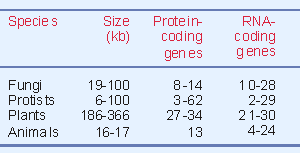7. Organelle genomes are circular DNAs that code for organelle proteins
3.7 Organelle genomes are circular DNAs that code for organelle proteins |
| Key terms defined in this section |
| ctDNA is chloroplast DNA. mtDNA is mitochondrial DNA. |
Most organelle genomes take the form of a single circular molecule of DNA of unique sequence (denoted mtDNA in the mitochondrion and ctDNA in the chloroplast). There are a few exceptions where mitochondrial DNA is a linear molecule, generally in lower eukaryotes.
Usually there are several copies of the genome in the individual organelle. Since there are multiple organelles per cell, there are many organelle genomes per cell. Although the organelle genome itself is unique, it constitutes a repetitive sequence relative to any nonrepetitive nuclear sequence.
Chloroplast genomes are relatively large, usually ~140 kb in higher plants, and <200 kb in lower eukaryotes. This is comparable to the size of a large bacteriophage, for example, T4 at ~165 kb. There are multiple copies of the genome per organelle, typically 20 V40 in a higher plant, and multiple copies of the organelle per cell, again 20 V40.
Mitochondrial genomes vary in total size by more than an order of magnitude. Animal cells have small mitochondrial genomes, ~16.5 kb in mammals. There are several hundred mitochondria per cell. Each mitochondrion has multiple copies of the DNA. The total amount of mitochondrial DNA relative to nuclear DNA is small, <1%.
In yeast, the mitochondrial genome is much larger. In S. cerevisiae, the exact size varies among different strains, but is ~80 kb. There are ~22 mitochondria per cell, which corresponds to ~4 genomes per organelle. In growing cells, the proportion of mitochondrial DNA can be as high as 18%.
Plants show an extremely wide range of variation in mitochondrial DNA size, with a minimum of ~100 kb. The size of the genome makes it difficult to isolate intact, but restriction mapping in several plants suggests that the mitochondrial genome is usually a single sequence, organized as a circle. Within this circle, there are short homologous sequences. Recombination between these elements generates smaller, subgenomic circular molecules that coexist with the complete, "master" genome, explaining the apparent complexity of plant mitochondrial DNAs.
 |
Figure 3.11 Mitochondrial genomes have genes coding for (mostly complex 1-4) proteins, rRNAs, and tRNAs. |
With mitochondrial genomes sequenced from many organisms, we can now see some general patterns in the representation of functions in mitochondrial DNA (for review seeLang et al., 1999). Figure 3.11 summarizes the distribution of genes in mitochondrial genomes. The total number of protein-coding genes is rather small, but does not correlate with the size of the genome. Mammalian mitochondria use their 16 kb genomes to code for 13 proteins, whereas yeast mitochondria use their 60 V80 kb genomes to code for as few as 8 proteins. Plants, with much larger mitochondrial genomes, code for more proteins. Introns are found in most mitochondrial genomes, although not in the very small mammalian genomes.
The two major rRNAs are always coded by the mitochondrial genome. The number of tRNAs coded by the mitochondrial genome varies from none to the full complement (25-26 in mitochondria). This accounts for the variation in Figure 3.11. The major part of the protein-coding activity is devoted to the components of the multisubunit assemblies of respiration complexes I-IV. Many ribosomal proteins are coded in protist and plant mitochondrial genomes, but there are few or none in fungi and animal genomes. There are genes coding for proteins involved in import in many protist genomes.
Are mitochondrial and chloroplast genomes unique or are some sequences shared between organelles or by an organelle and the nucleus? Plant mitochondria often have sequences that appear to have been acquired from chloroplast DNA. In some organisms, mitochondrial sequences have homologous regions in the nucleus. Exchanges of DNA between organelles or with the nucleus undoubtedly are rare, but occur in the course of evolution. The mechanism is unknown.
How did a situation evolve in which an organelle contains genetic information for some of its functions, while others are coded in the nucleus? Suppose that these organelles originated in endosymbiotic events, in which primitive cells captured bacteria that provided the functions that evolved into mitochondria and chloroplasts. At this point, the proto-organelle must have contained all of the genes needed to specify its functions. At some later time, some or most of the organelle genes must have been transferred to the nucleus. Perhaps this occurred at a period when compartments were less rigidly defined.
Sequence homologies suggest that both mitochondria and chloroplasts have evolved separately from lineages that are common with eubacteria, with mitochondria sharing an origin with α-purple bacteria, and chloroplasts sharing an origin with cyanobacteria. The closest known relative of mitochondria among the bacteria is Rickettsia (the causative agent of typhus), which is an obligate intracellular parasite that is probably descended from free-living bacteria. This reinforces the idea that mitochondria originated in an endosymbiotic event (involving a common ancestor with Rickettsia) and have since lost many of their original genes (for review see Lang et al., 1999).
This section updated 5-15-2000
| Reviews | |
| Lang, B. F., Gray, M. W., and Burger, G. (1999). Mitochondrial genome evolution and the origin of eukaryotes. Ann. Rev. Genet. 33, 351-397. | |